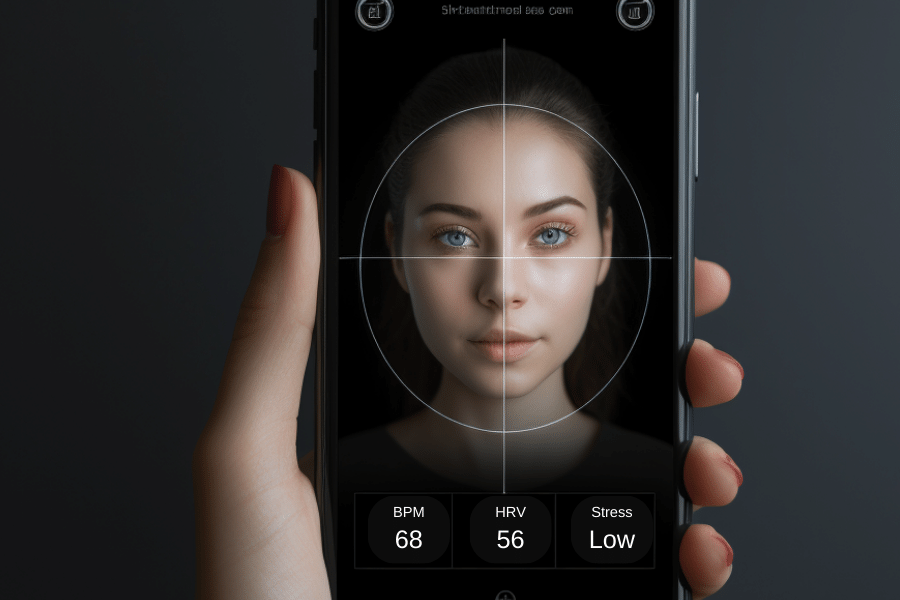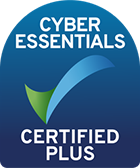Face scan technology has become increasingly popular in recent years, not just for security purposes but also in the healthcare industry. Using a technique called photoplethysmography (PPG) we can extract Health data from a selfie, using your camera on your mobile phone. By performing a simple face scan we can capture valuable health data and vital health information that can aid in remote health monitoring.
PPG involves shining light onto the skin and measuring the reflection of that light. This allows for the detection of blood flow and other physiological signals, which can provide insights into an individual’s overall health and specific health parameters. With advances in technology, this process has become more accurate and convenient, making it an attractive option for healthcare professionals.
Through face scans and PPG, health vitals can be obtained in a non-invasive and contactless manner, allowing for personalized healthcare interventions and proactive health monitoring. Let’s dive deeper into the process of capturing Health data from a selfie and explore its potential applications in remote health monitoring.
Health data from a Selfie- Key Takeaways
- Face scans ‘a selfie’ can capture health data and vital information using PPG.
- PPG involves shining light onto the skin and measuring the reflection of that light. rPPG involves the use of natural light shining on your face.
- Face scans and PPG can provide non-invasive and contactless health monitoring.
- This technology holds promise for personalized healthcare interventions and proactive health monitoring.
- Vastmindz is at the forefront of this innovation, revolutionizing the way we gather health data from a selfie from a simple face scan.
Understanding Face Scans and Photoplethysmography
Face scans are a non-invasive way to capture a wealth of health-related data about an individual without the need for traditional monitoring equipment. Photoplethysmography, or PPG, is the technique used to extract this valuable information from a face scan.
PPG is a non-invasive optical technique that detects blood volume changes in the microvascular bed of tissue by shining light into the skin. The reflection of light is then used to measure changes in blood flow and other physiological signals.
When using PPG to extract heath data from a selfie face scan on a mobile phone, the camera is used to capture short video frames of an image of an individual’s face. The camera uses natural light that illuminates the skin, and the reflected light from the skin is captured by the camera’s sensor which produces pixelated data points, all achieved with no contact. The pixelated face data is converted into RGB data signals which are transported to the cloud for processing in real time by the Vastmindz AI engine. In seconds the Health data from a selfie is displayed , this includes heart rate, heart rate variability, blood oxygen saturation, and other vital signs.
Health data from a Selfie and Photoplethysmography
Face scans and PPG have promising applications in remote health monitoring. One advantage of this technology is that it allows for convenient and non-invasive monitoring, enabling early detection of health issues and personalized healthcare interventions.
PPG can provide a wealth of data on an individual’s health status and how it changes over time. This information can be used to alert healthcare providers to potential problems before they become severe.
Moreover, remote health monitoring with facial scans and PPG is particularly useful for individuals who live in remote areas without easy access to healthcare facilities making Virtual Health Assessments with a Selfie a easy way to capture your health data from a face.
The Link Between Facial Scan and Health Vitals
A Facial scan can hold valuable information about a person’s health, providing a non-invasive and contactless way to monitor vital health data, making the process of capturing Health data from a Selfie an innovative and revolutionary tool for Virtual Health Assessments.
Facial features such as skin tone, complexion, and texture are all dealt with by the Vastmindz technology that manages and calibrates for different skin types in seconds.
By capturing Health data from a selfie and using photoplethysmography we can detect blood flow and other physiological signals in the face, providing real-time health vitals and personalized health information. This technique can measure heart rate, blood pressure, oxygen saturation, and even stress and anxiety levels. With this technology, healthcare providers can monitor patients remotely and catch early warning signs of potential health issues, allowing for proactive interventions and personalized care.
How Photoplethysmography Measures Health Data
Photoplethysmography (PPG) is a non-invasive technique that measures blood flow and other physiological signals through a face scan to extract valuable health data. PPG is based on the principle that blood absorbs light, so by measuring the changes in light as it passes through the skin, PPG can detect changes in blood volume. This method is often used to monitor heart rate and pulse oximetry, but it can also provide information about other parameters such as blood pressure, breathing rate, and hydration levels.
During a face scan, a natural light source illuminates the skin, and a the camera’s sensor detects the changes in light intensity as blood flows through the blood vessels. The data captured by the sensor is then processed to extract meaningful information about the person’s health status. PPG can detect subtle changes in blood flow that may indicate underlying health issues, making it a valuable tool for early detection and diagnosis.
PPG is a contactless and non-invasive method that can be easily incorporated into remote health monitoring systems. It requires no physical contact with the patient, making it ideal for use in situations where touching the patient may be difficult or impractical. PPG can also be used in conjunction with other monitoring techniques to provide a more complete picture of the patient’s health status.
What are the uses of Health data from a selfie?
The application of capturing Health data from a selfie in remote health monitoring is vast. With the COVID-19 pandemic forcing many medical facilities to close their doors, remote health monitoring has become an essential tool in ensuring patients receive the care they need.
One of the primary advantages of obtaining health data from a face scan is its contactless and non-invasive nature. Patients can receive health monitoring from the comfort of their own homes, reducing the risk of exposure and transmission of diseases. This is especially vital for patients with compromised immune systems, the elderly, and those with chronic health conditions.
| Advantages | Limitations |
|---|---|
|
|
Healthcare providers can use the health data obtained from a face scan to detect early warning signs of health issues and provide more personalized care interventions. By monitoring changes in a patient’s health vitals, healthcare providers can make proactive changes to their medical care, potentially avoiding emergency situations.
The applications of face scans and photoplethysmography technology are vast and continue to expand as further research and development progress. It has the potential to revolutionize the healthcare industry and enhance personalized healthcare interventions for patients globally.
Advantages and Limitations of Face Scans for Health Data
While the use of face scans and photoplethysmography to gather health data has shown great promise, there are also some limitations and challenges that need to be addressed. Here are some of the advantages and limitations of using face scans for health monitoring:
Advantages of Face Scans for Health Data
One of the main advantages of using face scans for health monitoring is the non-invasive and contactless nature of the technology. Unlike other methods for gathering health data, such as blood tests or physical exams, face scans do not require any physical contact with the patient. This makes them a convenient and less invasive option for remote health monitoring.
Additionally, face scans can provide a wealth of information beyond traditional health vitals like blood pressure or heart rate. By analyzing the health data from a selfie we can detect signs of stress, fatigue, and other indicators of general well-being.
Limitations of Face Scans for Health Data
Despite their potential benefits, there are also some limitations and challenges associated with using face scans for health monitoring. One of the main concerns is the accuracy and reliability of the technology.
Another challenge is the potential for bias and inaccuracies in the data gathered through facial scans. Factors such as lighting, camera angles, and facial expressions can all impact the accuracy of the data, and we continue to research to understand how to improve the accuracy
Lastly, there are also concerns about privacy and security when it comes to storing and sharing sensitive health data obtained through facial scans. Whilst we believe this may not be a technical challenge, it still remains a challenge where users may interpret the process of capturing health data from a selfie as a process that send’s images of their faces for processing.
The Future of Face Health Vitals and Photoplethysmography
As with any emerging technology, the future of capturing health data from your face and photoplethysmography is full of exciting prospects and potential advancements.
At Vastmindz, our team is committed to staying at the forefront of these developments and leveraging them to enhance the accuracy and usefulness of face scans and photoplethysmography. We believe that this technology has the potential to revolutionize healthcare by providing personalized and proactive health monitoring that is accessible to everyone, everywhere.
Conclusion
In conclusion, face scans and photoplethysmography have opened up new possibilities in capturing health data and vital information remotely. The utilization of this technology holds promise for personalized healthcare interventions and proactive health monitoring. With further advancements and research in this field, we can expect face scans to become a routine practice in healthcare and an integral part of remote health monitoring.
At Vastmindz, we are at the forefront of this innovation, revolutionizing the way we gather health vitals from a simple face scan. We believe in the power of technology to improve healthcare outcomes, and our cutting-edge solutions are designed to provide accurate and reliable health data from a face scan. Whether it is for personalized healthcare interventions or remote health monitoring, our face scan technology has the potential to transform the future of healthcare.
So, to harness the power of face vitals from a face scan and health data from a face scan, look no further than Vastmindz contact us today for a demo.



